I like interesting use of dice. Grand Austria Hotel is one of my favourite games ever, Castles of Burgundy used to be at some point. I really enjoy Troyes, even if my friends don’t want to play it with me, and I enjoyed Woodcraft to name a more recent title. So when I heard of Tiletum, I was intrigued even though the images I saw turned me off. It does look pretty beige, doesn’t it?
Still, the core mechanism sounded really clever. So off I went…
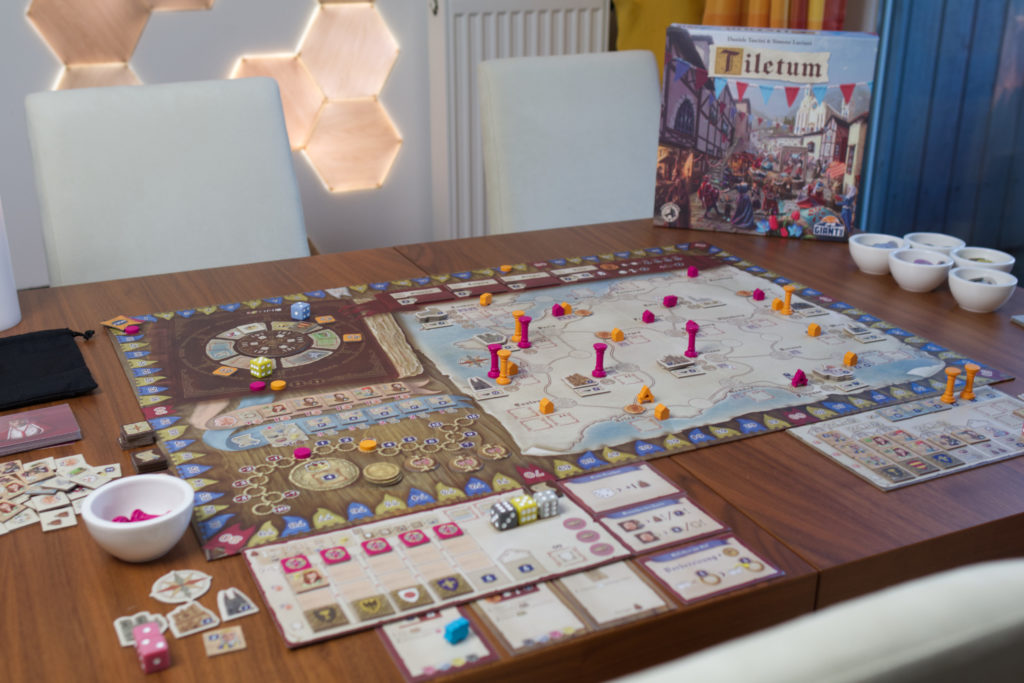
Setup
… into my first issue with the game: Setup times are quite substantial. There are five different resources, three types of tiles (each of which containing tiles that need to be removed per player count), player pieces that need to be placed on the player boards, bonus tiles that need to be put into cities, cathedral tiles that need to be sorted, dice that needed removing from the bag based on player count, city names drawn, etc. To make a long story short: even with the proper use of ziplock bags, it takes a bit to set this game up.
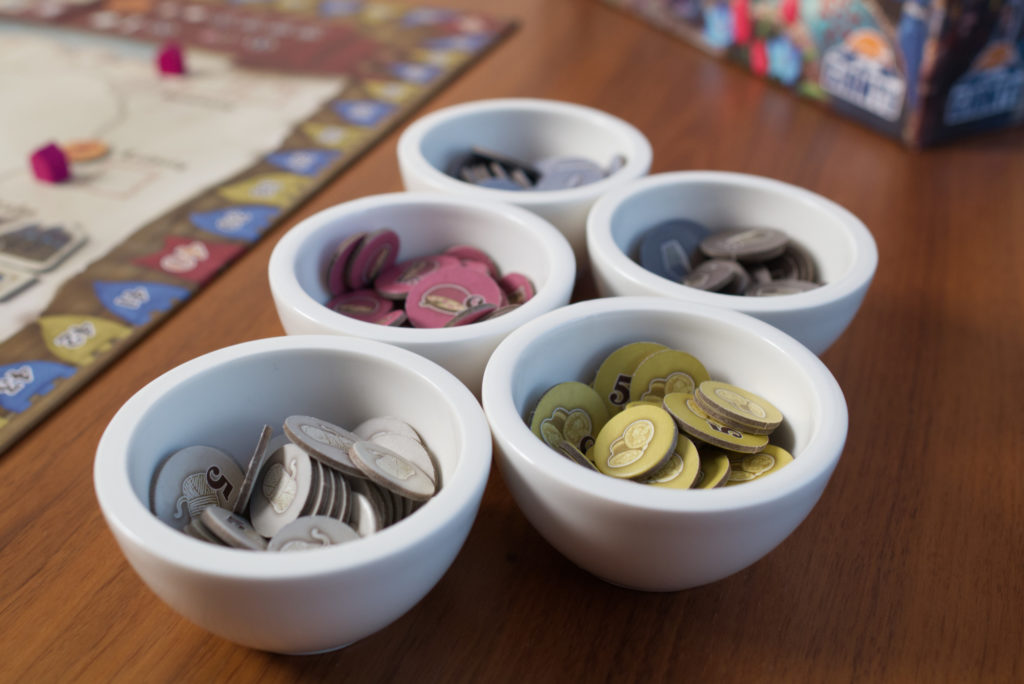
When it comes to the map, all players place their architect and trader pieces into the city of Tiletum which will also be where the first of four trade fairs will occur. The other three cities are drawn at random, as will the scoring criteria for each fair (such as x VP per house build, x VP based on number of fulfilled contracts, etc). The map shows various cities in Europe where cathedrals wait to be erected with places to built columns (basically your building permit) and houses (qualifying you to participate in the end-round fairs). There are bonuses to collect and VP to score, it’s all very non-descriptive. So let’s instead look at the round structure.
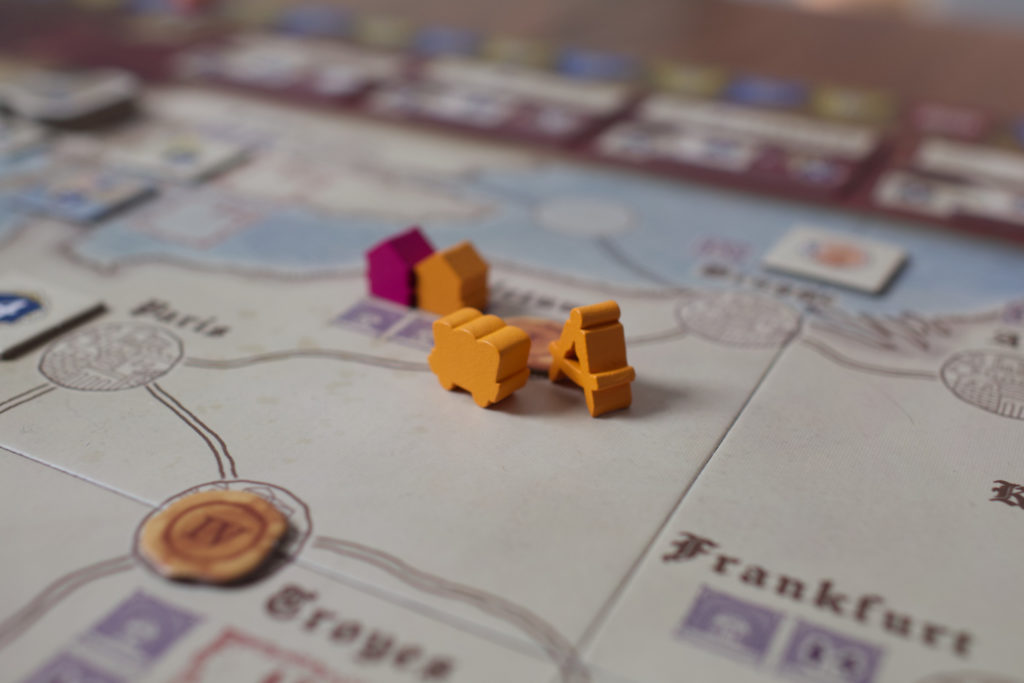
The Round Structure
The core element of the game is its action wheel which’s inner part (a loose cardboard disc) turns one step at the end of each round. At the beginning of a round, one die per color per player is placed into a bag and most of them are drawn and placed onto the action wheel. The inner part shows where the individual die values have to be placed and the outer part what the associated action is. During a player’s turn, they will pick one of the available dice and place it on their board. The color and pip value indicate how many resources that player gets (e.g. a yellow 5 means 5 gold), and 7 minus the pip value is the number of action points the player can spent.
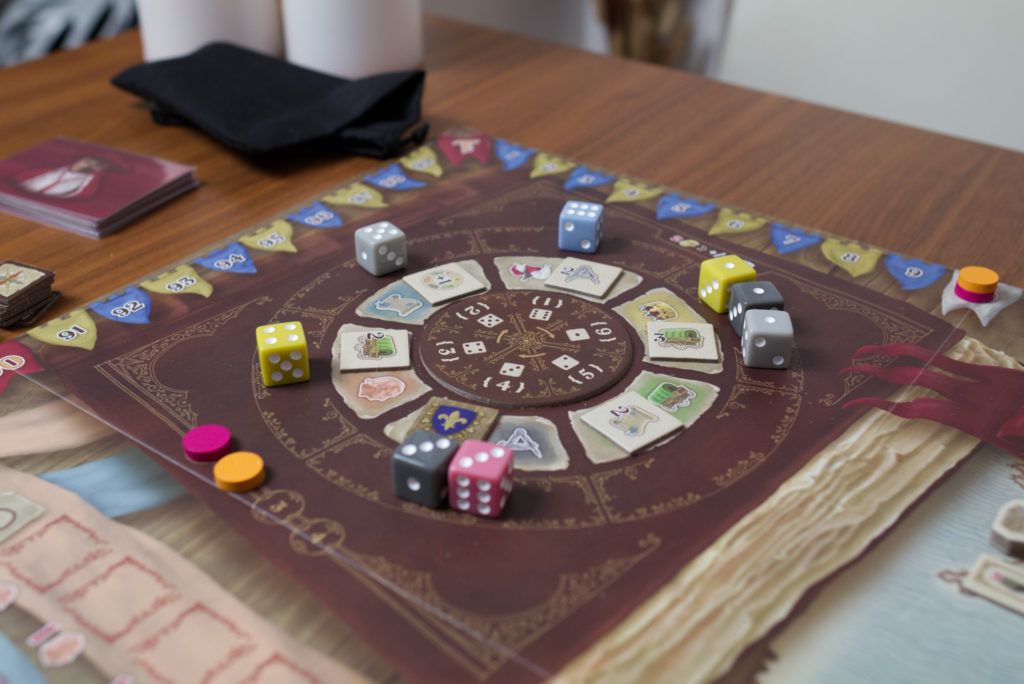
Everyone does that three times and then the round concludes with a scoring of the king track and a trade fair. The former decides who will be starting player in the next round and assigns positive or negative VP. On three occasions during the round, a tile is revealed and all players are moved down a couple of steps on the track. So players have to actively invest in advancements on this track or they will lose VP.
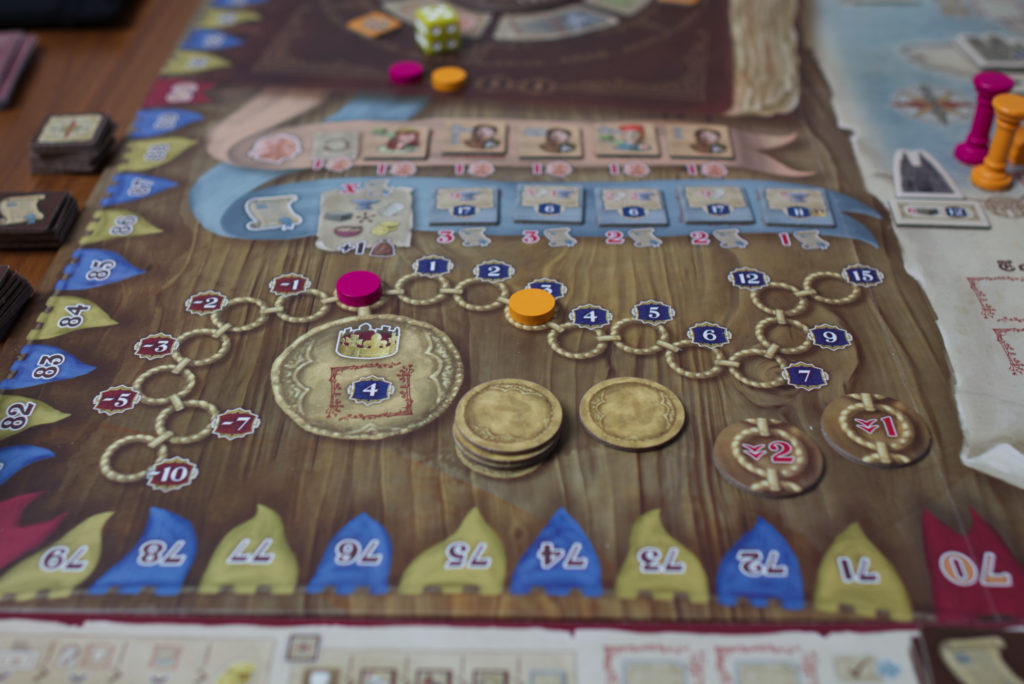
The fairs on the other hand reward VP for a specific criteria that is drawn during setup. However, a player only partakes in a fair if that player’s trader ends its turn in the city hosting the fair – or – if they previously have built a house in that city.
That’s it. Repeat three more times, do a final scoring and we have a winner.
Actions
Where Tiletum shines are the types of actions one can use and how they can lead to huge combos. Pick a die on the architect slot and you can move your architect, erect a column in a city or pick up a bonus tile in the architect’s current city. The trader acts similar but places a house instead of a column. Both are indirect ways to get victory points: as a free action, a player can spent stone to build a cathedral in any town they have a column of their color as long as they haven’t already build there before. The trader – as already mentioned – qualifies a player for scoring VP during the trade fairs. So far, so simple.
Where things get interesting are the bonus tiles that are placed on the map during setup and can be picked up by either piece. These range from some free resources, the ability to change a die’s colour or award VP to additional actions that can be spent, even ones that don’t match the type of action you might currently be doing. So an architect might move, place a column, move again, pick up a tile with a guest symbol on it and suddenly you can perform 2 action points of the guest action, which in turn allow you to place a guest that gives you an immediate bonus of some wool that you needed to now fulfil a contract. This opens up the space of possibilities by a lot and correct timing/interleaving can lead to huge turns.
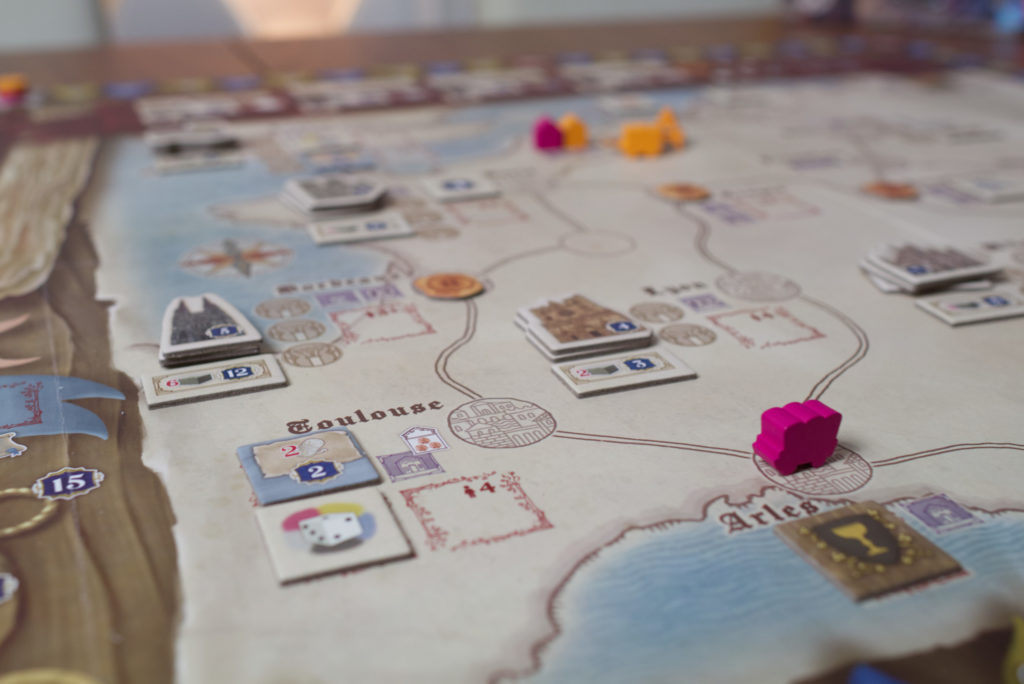
Speaking of guests, they are another type of action and associated mechanisms. Guest are picked up from a shared market by spending AP and placed into a limited storage area on the player board. With additional AP, the player can later place them into one of five houses (=columns). Why should one do this? Guests not only reward small bonuses when being placed. Full houses on the player board are needed to unlock additional houses (the wooden pieces) for the trader to place. Also if one manages to fill a house as well as place a coat of arms underneath it, a particular type of action shown on the action wheel gets boosted for the rest of the game (e.g. +2 AP whenever using the architect action). Placing a coat of arms has another effect: it triggers an immediate bonus like teleporting the trader to any city on the map or building a column in any city.
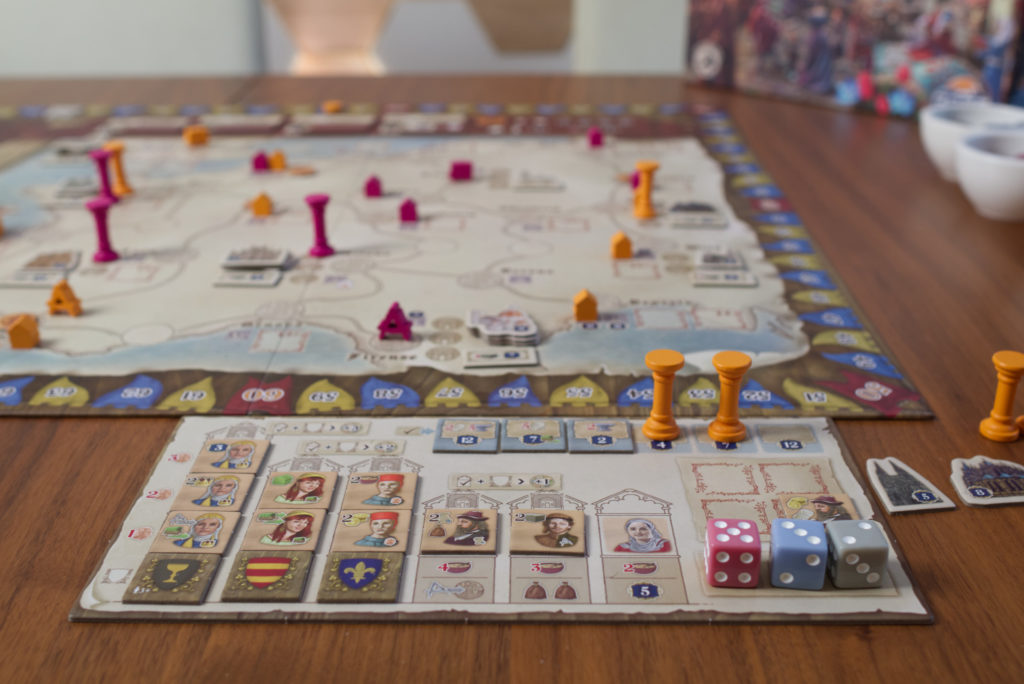
The contract action introduce yet another mechanism: order fulfilment. Contracts are acquired from another shared market and show a combination of resources. By paying the indicated resources, a player can at any time score the amount of VP shown on the tile as well as additional VP shown on the player board which increase the more contracts are fulfilled. Doing so is also important because it is what unlocks further columns for the architect action. Same as with the trader’s houses, a player starts with only a few available at the start of the game and before long, one will run out unless one fulfils a contract.
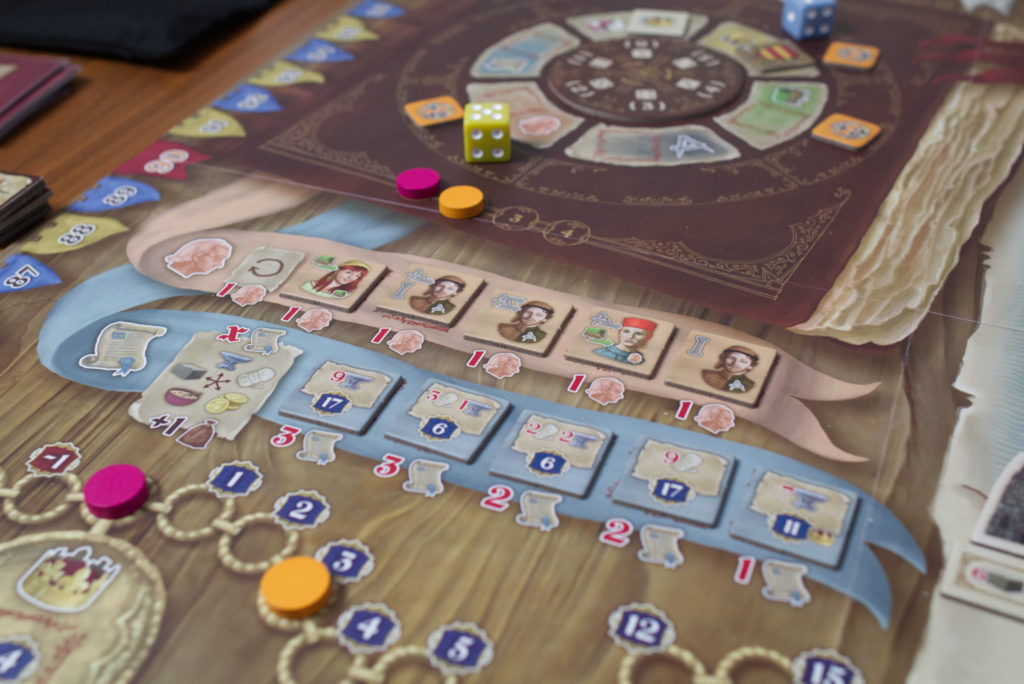
The last two actions are rather simple to explain: the king action moves a player’s marker up the king track, one step per AP, and the joker action allows the player to choose any one other action and spent it’s AP on that action type instead.
What has to be stressed here is how interconnected everything is: Architect and trader can be used for their primary purposes or to snatch up bonus tiles that unlock completely other things, fulfilling contracts unlocks further columns, placing guests unlocks houses, placing coats of arms in full houses boosts an action type … and if that wouldn’t be enough, the first player to pick any action type also gets another bonus tile.
Speaking of which: all tiles – guests, coats of arms, contracts, helpers (the game’s term for all the other bonus tiles) – have to be placed onto one of four storage slots on the player board. Got no space left? What a shame, you cannot pick up another as one cannot just discard tiles once picked up.
End of Game
The game ends after four rounds of three actions per player with 1-6 AP per action. That doesn’t sound that much at first. But due to the bonus tiles and various effects, executing a single action can take a bit if things go well. Players will have earned most VP by participating in the trade fairs or by fulfilling contracts, with additional points added or subtract when scoring the King track. The final scoring awards further VP for completed houses on the player board, for building lots of columns and houses, as well as a little bit of compensation for remaining resources.

Solo Mode
The solo mode in Tiletum is a rather standard automa that gets in your way, snatches up tiles and scores VP during trade fairs. It works, although it takes a bit to work through the separate rule book that exists for the automa alone. Once one gets used to it a bit, it is easy to administer… but otherwise not really worth much comment. I found it unmotivating to play against it, neither good or bad, just there as an option to use.
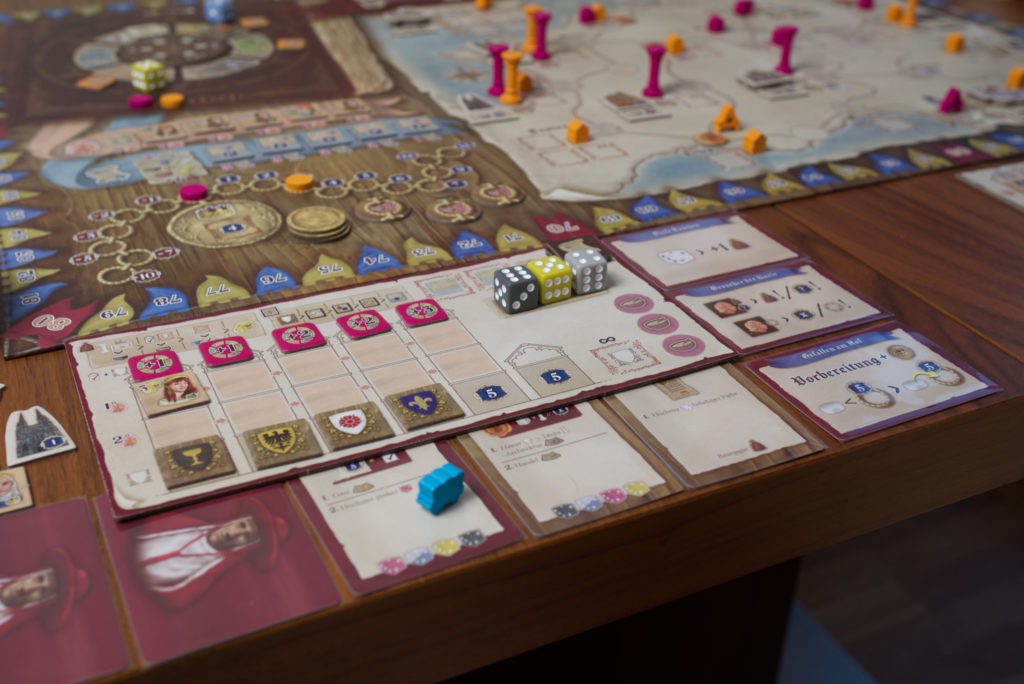
Conclusion
There you have it, that’s more or less Tiletum. I have a hard time to convey how brilliant the core mechanism and the interconnectedness of the various components are, frankly because I fail to muster a lot of enthusiasm for them. So let me spell it out: mechanically, this game is amazing. It’s well balanced, the possibilities for comboing are amazing, small tweaks to a turn can snowball into huge effects. Best of all, the initial setup of fair cities and scoring criteria heavily influence what strategy one has to pick. Sometimes it makes sense to build a lot cathedrals, sometimes it’s better to rather fulfil contracts.
Tiletum should be everything I like, and in some respect it is. During my very first game, it only took us a couple of actions for me and my opponent to both have a huge grin on our faces because Tiletum was so much fun. But after each game I played, I always had the same hollow feeling. The best image I could think of is that Tiletum feels to me like a bag of chips: after much development, it’s optimised to perfection. It’s great while I’m at it. But once I’m finished with it, I keep wondering if I should have consumed something else instead.
There is hardly any theme to what one is doing in Tiletum, there are few memorable moments, no great achievement in the end. In that sense, one could almost call Tiletum an abstract game. But for an abstract, I’m too much playing against the game and too little against my opponent. Sure, things like snatching away a good building place, die or bonus tile from your opponent has huge consequences for their turn. But I often found my thoughts drifting away from my opponent’s move while they executed it because I needed to focus on my own next turn.
Then there is the amount of randomness that is introduced by the dice. If you’re going for coats of arms and then no pink die (required to produce the food that one needs to activate coats of arms) comes out, you’ll definitely not have a good time. Turn order is also unusually important for a similar reason: imagine being second player when only a single pink die comes out of the bag. Your opponent has the key to unlock a lot of options while you are sitting there and might have a problem because your storehouse of tiles is full and you needed food to activate the coats of arms. Sure, one can trade resources with the contract action, but that costs a lot of AP your opponent does not have to pay.
The game’s art also doesn’t help to put much soul into it. The graphics are so beige that even my original edition of Castles of Burgundy, a game heralded for its beige-ness, looks cheerful compared to it. But I was surprised to find that the more I played Tiletum, the more I liked the little details that I didn’t see at first. For example, I really like the resource tiles and their color scheme, even if it causes problems when it comes to the dice because there is light grey, bluish-grey and dark-grey, all representing different resources. The wooden tokens for architect and trader are also really cute, same for the graphics on the cathedral cardboard tiles. But that map, that is still just pretty bland…
In aggregate, Tiletum somehow manages to be utterly disappointing to some and game of the year to others. Same as a bag of chips is refined to make your mouth fill with saliva or a mobile game is optimised to give you small boosts of endorphins every couple of minutes, Tiletum feels like a quintessential euro experience. It triggers all the right nerves. But in the end, it lacks substance … that is unless you are looking just for that dose of pure euro goodness. Is it fun: yes, definitely. Would I play it again: probably not. I’ve played it enough times to figure out that for me, personally, there is no real reason to do so.
